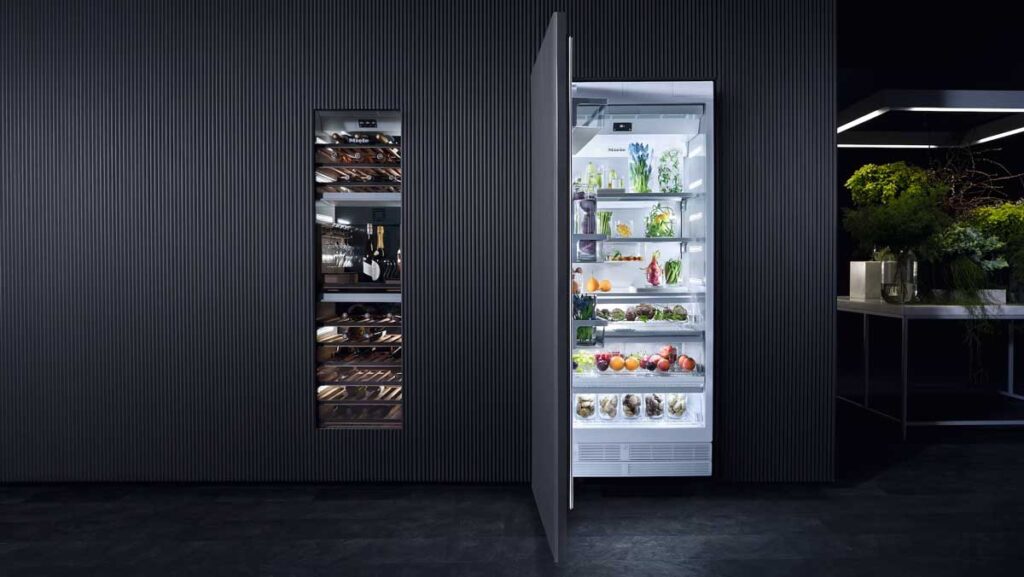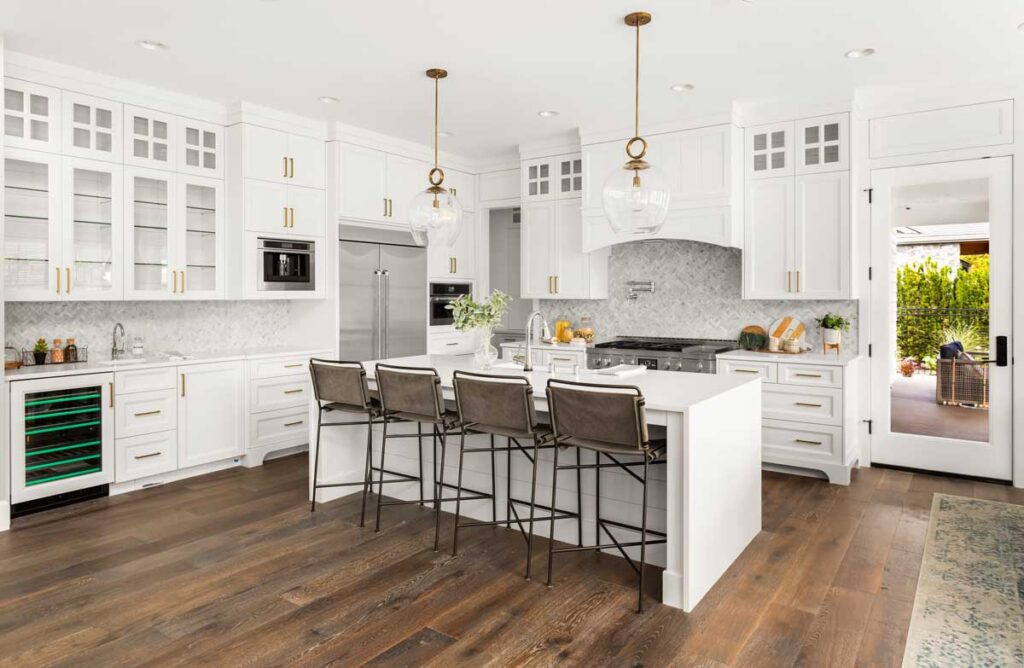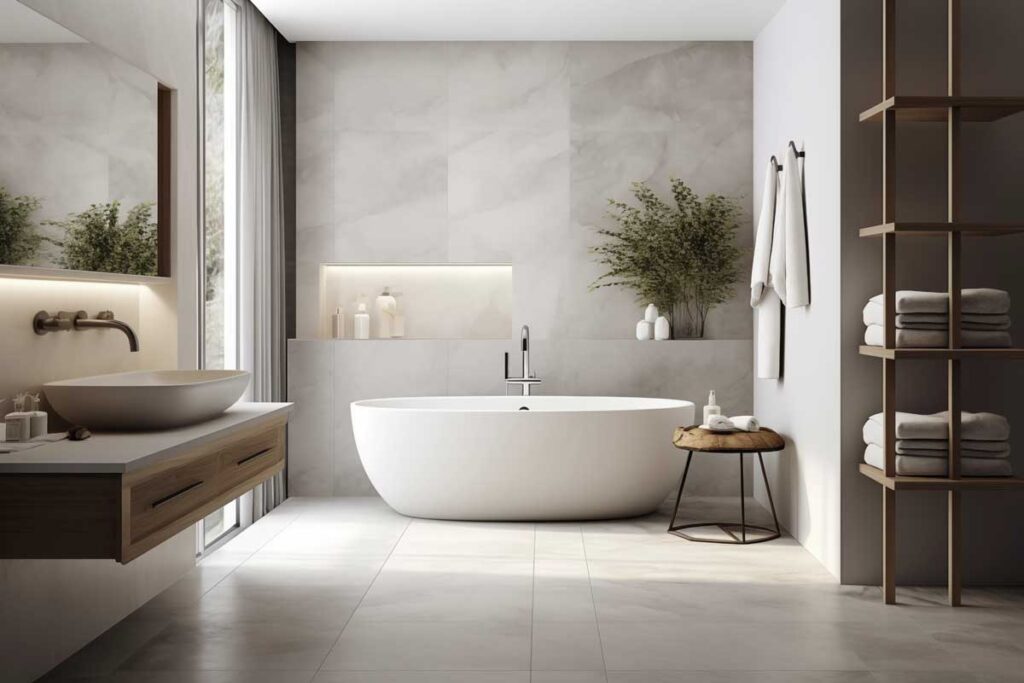
By Donna Heiderstadt
As NKBA | KBIS celebrates National Kitchen & Bath Month throughout October, we asked several leading interior designers to discuss the merger of luxury and functionality in small kitchen and bath spaces. Sometimes expanding a space’s footprint isn’t possible, whether it’s a first-floor powder room or a condominium kitchen with shared walls, and that’s where these high-end residential designers shine. Each of them — Gina D’Amore Bauerle of Denver-based D’Amore Interiors, Trish Knight and Nicole Varga of Vancouver-based Knight Varga Interiors, and Bahar Zaeem and Shima Radfar of Toronto-based RZ Interiors — has won a recent NKBA | KBIS Design Award for creating compact spaces that deliver both practicality and visual impact.
Here’s what they had to say:
Gina D’Amore Bauerle, Owner and Designer at D’Amore Interiors, Denver

How to make a small space functional and luxurious: “The most important element to consider in the design of smaller spaces is scale — which conversely can also be said for very large spaces,” she notes. “Once the functionality of a space has been properly planned, there really are no limits to the design selections as small spaces often call for even more wow factor moments.”
Top small-space design tips: In Bauerle’s opinion, these factors matter.
• Don’t be afraid to be bold: “I wish media influencers would stop scaring people about making bold choices in small spaces,” she says. “In reality, you have to try even harder to incorporate the ‘wow’ because you have less opportunity to make a statement.”
• Forget the word “timeless”: “Once you’ve established your givens, there is no reason to start making ‘safe’ design choices in an attempt to be ‘timeless’ — FYI: I hate that word! — or to not ‘overwhelm’ the space,” she says. “Be overwhelming! No one has ever dropped their jaw walking into a room where someone was restrained and played it safe.”
• Embrace a client’s inner bohemian: “I believe in bohemian design for all my clients, which in its purist sense means that they are being surrounded by the things they love,” she explains.
• Assign a purpose: “In kitchens, identify each cabinet’s purpose and assign interior organizers and mechanisms that allow people to fully utilize the cubic square footage they have,” Bauerle advises.
• Don’t add what’s not necessary: “Appliances should be chosen based on a combination of the homeowner’s cooking habits and the space itself,” she says.
• Celebrate the powder room: “Small spaces should never be treated as less important areas,” she says. “Powder rooms are one of my absolute favorite spaces to design because everyone uses them, so I want to create a moment in time that is completely unexpected and worth talking about post visit!”
Her favorite products that deliver lots of drama in smaller proportions: Bauerle says she often opts for the following when space is at a minimum:
• Workstation sinks — even the petite ones are highly functional.
• Dramatic lighting — this can be achieved with amazing decorative fixtures, but also with LED strip lighting that allows you to accentuate and illuminate the details.
• Floating cabinetry — it reduces bulk and tricks the eye into seeing more floor space.
Her go-to brands: Stone Forest sinks and vanities, Native Trails vanity tops integrated with sinks Kohler wall-mounted toilets, smaller Bluestar ranges in their fun colors and finishes, and Invisicook induction cooktops that are hidden beneath the countertop, leaving the counter surface free to serve other purposes.
Trish Knight and Nicole Varga, Principals of Knight Varga Interiors, Vancouver

How to make the most of a small kitchen space: A top tip is to keep your counters clutter-free with the help of a breakfast bar behind closed doors. “This handy space is perfect for small appliances like the toaster, coffee maker, and blender,” says Knight. “Extend the counter into it for durability and plan to store bowls, mugs and small plates along with bread and cereals to make it easy for family to quickly make their own breakfasts.”
Additional kitchen tips:
• Keep it simple: Consider a monochromatic look regardless of whether you prefer light, dark, or wood kitchens. “The simplicity of this will make the space feel bigger,” she notes.
• Take advantage of millwork corners: “Le Mans units offer easy access and maximum storage and extend all full-height cabinets and upper cabinets to the ceiling,” she says.
• Include shallow pantry storage: “A favorite trick is to add full-height shallow pantry storage, 6-12-inches deep along the wall in a kitchen not quite wide enough for full-depth pantries,” she adds. “This will hold all glassware, dry goods, and most canned/packaged food.”
• Think about the sink: “Our favorite sink for small spaces is the Social Corner by Home Refinements,” Knights says. “This allows two people to easily access the sink at the same time when cooking together.”
Top product recommendations for small kitchens: “We love using dual-function appliances in small spaces,” says Knight. These include Fisher & Paykel’s Cool drawer, which can be temperature controlled from crisper to freezer depending on what is needed in the moment, and a speed oven, which is a combination microwave and convection oven, or a steam oven, which can also be used as a convection oven.
Tips for making the most of a small bathrooms: “Small powder rooms are jewel boxes for creativity and can be highly functional in very little space as they serve a single purpose,” Knight notes. Here are some suggestions:
• Consider a wall-mounted faucet and vessel sink on a shallow counter/cabinet: “This will make the room visually appear larger, she says. “If it’s possible to add a window, make it a big one — bringing the outdoors in will add to the feel of the space.”
• Don’t be afraid of adding personality with wallpaper: “It’s a nice surprise for your guests,” she says. “We used a bold floral in one project as gardening is our clients passion.”
• Consider tiling all the walls in a small en-suite bathroom. “This will add to the luxurious feel and make cleaning easier too,” she notes. “If budget allows, Dekton slabs are a great option too — work with a 8mm or 12mm for ease of install.”
• Have a vanity strategy: Design the vanity with a taller base or float it off the wall to allow for a more spacious feeling. A deep recessed kick can be added 12 inches back to provide stability without being seen.
• Continue the floor tile into the shower: “And splurge on something special!” she says.
• Add a ledge between the counter and the mirror: “Run it the full length of the wall, which allows you a small space for something decorative like a plant without taking up counter space,” she suggests.
Bahar Zaeem and Shima Radfar, Principals of Toronto-based RZ Interiors

How to make a small space both functional and luxurious: “Designing for smaller spaces requires a balance between functionality and creativity,” says Radfar. “Thoughtful use of vertical space, intentional cabinetry, and bold design choices ensure that even the smallest areas can feel expansive and luxurious.”
Tips for small bathroom design: “In more compact spaces, the details truly make a difference,” says Zaeem. For example, in smaller bathrooms, she and Radfar have embraced the following:
• Slim-profile toilets without tall tanks: “Their streamlined design minimizes the footprint, giving the room a more open feel,” she says.
• An integrated faucet deck in the sink design: “This approach allows the faucet to be mounted directly onto the sink structure, achieving a clean, minimalist look,” says Radfar. “The faucet deck is crafted from the same material as the sink, allowing us to reduce the depth of the vanity and create more open space without compromising on elegance or functionality.”
Tips for maximizing small kitchen functionality: In kitchens with limited square footage, the designers employ the following strategies:
• Choose integrated appliances: “We often turn to panel-ready fridges and freezers from brands like Fisher & Paykel or Sub-Zero, which blend seamlessly into the cabinetry and reduce visual clutter,” says Zaaem. “One of our newest features is adding functional drawers beneath the kitchen sink, complete with dividers for cleaning supplies. It transforms what is typically wasted space into an organized storage solution.”
• Maximize storage and functionality: You can maximize space with closed cabinetry, which allows for ample storage while also creating functional zones. These cabinets can house countertop appliances, or even provide additional surfaces for a coffee station. “This approach combines practicality with elegance, ensuring every inch of space serves a purpose without compromising on aesthetics,” Radfar says.
• Utilize texture: The duo notes that texture plays a pivotal role in smaller kitchens. “For example, in an all-black kitchen, we may use flat panel cabinetry alongside ribbed black cabinet accents in the same tone to introduce character and intrigue, proving that monochrome doesn’t mean monotonous,” Zaeem says.
• See the light: “Intricate light fixtures illuminate corners and niches, creating layers of interest that draw the eye and transform these compact spaces into something truly special,” notes Radfar.
• Pay attention to scale: “One of the key design tips is to ensure the cabinetry is proportional to the room,” says Zaeem. “Large, tall cabinet doors in a small space can overwhelm the room and make it feel more confined.”
• Make use of the full height of the room: If there’s a bulkhead, extend the cabinets to the ceiling to conceal it and create a seamless, uninterrupted look. “This helps eliminate visual breaks, making the space feel taller and more cohesive,” notes Radfar.
• Fancy up the fridge: Standard panel-ready refrigerators are typically 82” to 84” tall, which leaves an awkward gap when ceilings are taller. “Instead of adding a small cabinet above, we recommend extending the panel door to full height, either up to the ceiling or to align seamlessly with any adjacent full-height cabinetry,” Radfar says. “This approach creates a streamlined, cohesive look.”
• Get creative with the island: “If space permits an island, I always encourage clients to make it a bold, functional centerpiece,” says Zaeem. “Rather than opting for the typical waterfall edge, consider creative options like an interesting counter edge profile or a partial wrap where the countertop extends down the side without fully enclosing it.”






















